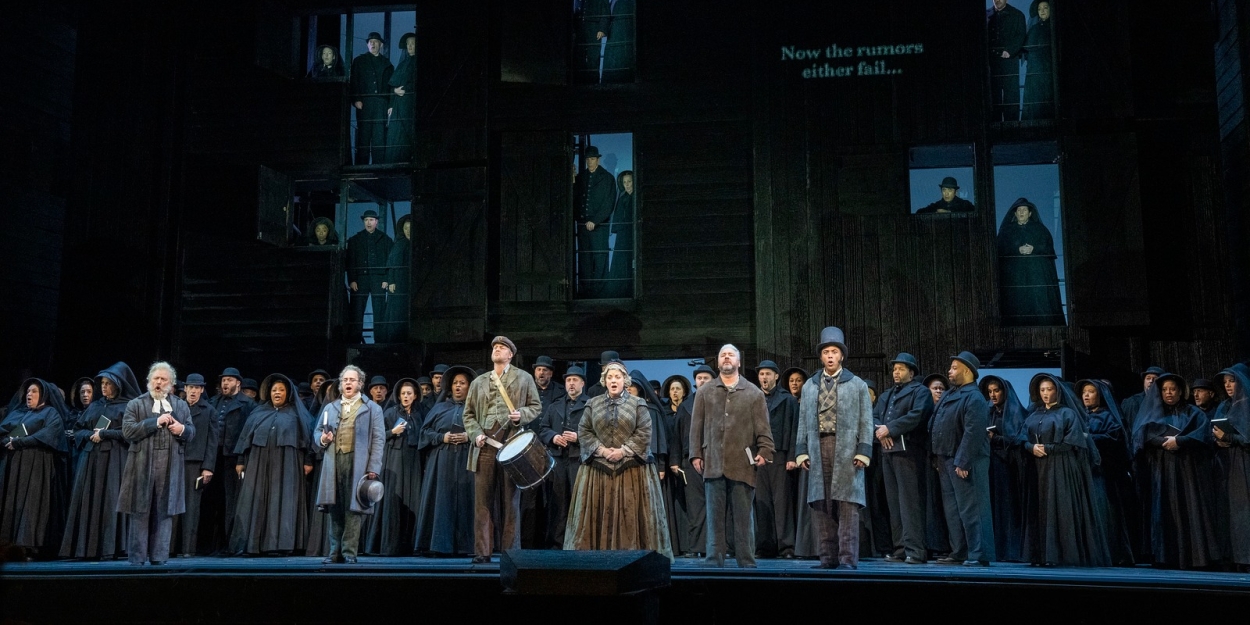Review: October 16 Season Premiere of PETER GRIMES at The Met
Now through November 12th.

One of the momentous events of the first season at the new Metropolitan Opera at Lincoln Center (and there were many) was the new production of Benjamin Britten's PETER GRIMES in 1967. Although it had its Met premiere in 1948 at the old house, it was the Tyrone Guthrie production that cemented its place in the Met repertory. Starring Jon Vickers as its protagonist, it served to introduce his portrayal to a generation relatively new to the opera. For approximately the next twenty years Vickers would play Grimes at most revivals. Since then, there have been others who have played the role-Philip Langridge, Anthony Rolfe Johnson, and Anthony Dean Griffey-and left their mark on this almost mythical role.
Benjamin Britten was, of course, British by birth and lived most of his adult life at Aldeburgh, near the North Sea. He incorporates the sea into PETER GRIMES, almost to the point here it becomes one of its main characters. The Four Sea Interludes that bridge a number of the scenes have become stand-alone concert pieces. The opera is based on a poem by George Crabbe called THE BOROUGH about a fishing village and its inhabitants, one of whom is Peter Grimes, whose behavior and attitude immediately brand him an outcast. His actions, his extreme moods, and a lot of bad luck, alienate him from the others and lead to his eventual demise.
Britten wrote the opera with his life partner, Peter Pears, as the antihero and it was he who sang the premiere. Britten identified with Grimes as an outsider and enhanced Grimes' musical lines with outbursts of extreme anger, monologues of great beauty and a "mad scene" toward the end of the piece.
Briefly, Grimes, a fisherman has lost his apprentice at sea due to a shortage of drinking water.
The inquest at the opening of the opera acquits him but the circumstances trigger the town's intense scrutiny from that point onward. Ellen Orford, the schoolmistress, offers him aid and friendship, as does another fisherman, Captain Balstrode. As the opera progresses, Grimes resents the townfolk's constant gossip and interference and gradually loses control. He is suspected of having physically brutalized his first apprentice and, indeed a second apprentice who works for him slips off a cliffside and dies. Balstrode tells Grimes to sail his ship out of site of land and sink it, drowning himself as well. The final tableau is of a diffident townsfolk taking note of, but not really caring about, a sinking ship on the horizon.
The Metropolitan Opera, following on the great successes of the last few weeks, has mounted a revival of the 2008 production of PETER GRIMES, directed by John Doyle, with sets by Scott Pask, and costumes by Ann Hould-Ward. The title role was sung in a strong, heroic manner by Allan Clayton, who had a great success last season in Dean's HAMLET. His rage at the townspeople was palpable as was his frustration at being unable to control himself and merit Ellen's love. Ellen was sung beautifully by Nicole Car, who was forceful when it came to defending Peter, and tender in her scenes with the young apprentice, well-acted by the young Brandon Chosed. Her voice effortlessly rode the orchestral climaxes but she was able to scale down her voice at more intimate moments. Adam Plachetka made a solid Balstrode with his sturdy bass-baritone. Denyce Graves as Auntie and Michaela Martens as Mrs. Sedley added vocal luster to their characterizations, as did Justin Austin and Chad Shelton as Ned Keene and Bob Boles.
Nicholas Carter, conducted the flawless Met Orchestra in a work where its evocation of the sea is crucial to making the performance a success. The sea interludes were heart-rending.
The Met Chorus under Donald Palumbo was frightening in its intensity.
The production itself is basically a unit set representing the town. It is a flat wooden wall with openings, representing windows, which periodically open and close to allow characters to emerge briefly. But PETER GRIMES is set in a specific locale and a specific time (1830's) and demands more realism in its stage pictures. A courtroom should look like a courtroom and a tavern should resemble one. The costumes were quite evocative, however.
Those quibbles aside, everyone interested in Britten, 20th century opera and great voices should see this wonderful revival.
Photo Credit: Richard Termine
Comments
Videos

